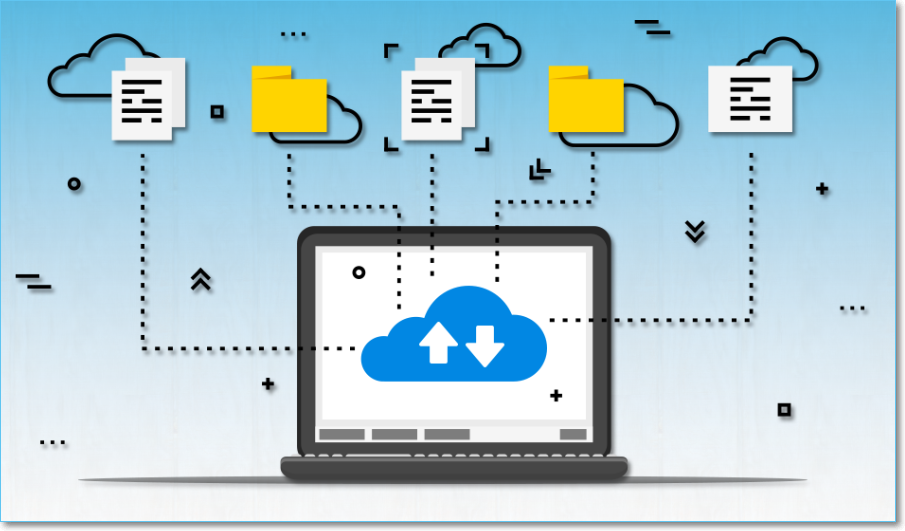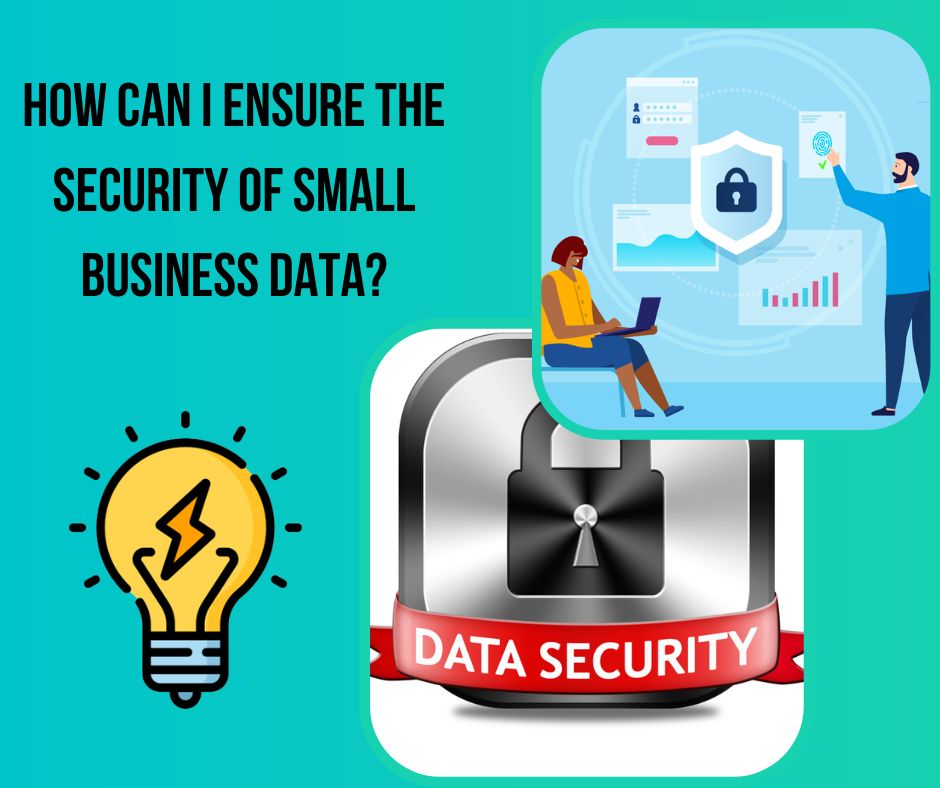How to choose the right IT support provider for small business: Security of small business data: Ensuring the security of your small business data is critical to protecting your company’s intellectual property, financial information, and customer data. Here are some steps you can take to help ensure your data is secure: Below you get more tips regarding security of small business data.
Identify and assess potential risks:
The first step is to identify the potential risks to your business data, such as cyber-attacks, data theft, unauthorized access, and system failures. Once identified, assess the severity and likelihood of each risk to prioritize your security efforts.

Identifying and assessing potential risks is a critical step in securing your small business data. Here are some steps you can take to do this:
Conduct a risk assessment:
A risk assessment is a systematic process of identifying, analyzing, and evaluating potential risks to your business data. It involves identifying all the potential threats to your business data, such as cyber-attacks, natural disasters, or employee errors. You can then assess the likelihood of each risk occurring and the potential impact it could have on your business.
Review your existing security measures:
Review your existing security measures and assess their effectiveness in protecting your business data. Evaluate whether your current security controls are sufficient to mitigate the identified risks.
Identify vulnerabilities:
Identify any vulnerabilities in your systems or processes that could be exploited by attackers. This may include outdated software or hardware, unpatched systems, or unsecured access points.
Evaluate the impact of a breach:
Consider the potential impact of a breach on your business, including financial losses, damage to your reputation, and legal liabilities.
Determine the level of risk tolerance: Determine the level of risk your business is willing to tolerate. This will help you prioritize your security efforts and determine how much to invest in security controls.
Create a risk management plan:
Based on the results of your risk assessment, create a risk management plan that outlines the steps you will take to mitigate identified risks. This may include implementing additional security controls, conducting regular security audits, or purchasing cybersecurity insurance. Below you will find more points regarding How to choose the right IT support provider for small business.
By identifying and assessing potential risks, you can better understand the threats to your business data and take steps to mitigate them. This can help you protect your business from potential security breaches and minimize the impact of any incidents that do occur.
Read More:
Implement strong passwords:
Ensure that you and your employees use strong passwords and change them regularly. Encourage the use of complex passwords, including a mix of upper and lowercase letters, numbers, and special characters.

Implementing strong passwords is an essential step in securing your small business data. Here are some best practices for creating and managing strong passwords:
Use complex passwords:
Use complex passwords that are difficult to guess. A strong password should be at least eight characters long and contain a mix of uppercase and lowercase letters, numbers, and special characters.
Avoid using common words or phrases:
Avoid using common words or phrases, such as “password” or “123456,” as these are easily guessable by attackers.
Avoid using personal information:
Avoid using personal information, such as your name, birthdate, or address, as part of your password. This information is often publicly available and can be used to guess your password.
Use different passwords for different accounts:
Use a unique password for each account, as this reduces the impact of a data breach. If an attacker gains access to one of your accounts, they won’t be able to use the same password to access your other accounts.
Change passwords regularly:
Change your passwords regularly, such as every 90 days, to reduce the risk of a successful password guessing attack. This is especially important for accounts that contain sensitive data.
Use a password manager:
Consider using a password manager to generate and store complex passwords securely. A password manager allows you to generate and store unique passwords for each account, making it easier to manage your passwords.
Educate employees on password security:
Educate your employees on the importance of password security and best practices for creating and managing strong passwords. Encourage them to use unique and complex passwords, and remind them to change their passwords regularly.
By implementing strong passwords, you can reduce the risk of a successful password guessing attack and protect your small business data from unauthorized access.
Secure your network:
Set up a secure network with firewalls, antivirus software, and intrusion detection systems. Make sure that all software and hardware are kept up-to-date with the latest security patches and updates.

Securing your network is an important step in ensuring the security of your small business data. Networks are a vital part of any business, connecting computers, devices, and servers together to enable efficient communication and collaboration. However, without proper security measures, networks can also provide a pathway for cybercriminals to gain access to sensitive business data. Below you will find more regarding How to choose the right IT support provider for small business. Also the security of small business data.
Here are some key steps you can take to secure your network and protect your small business data:
Use strong passwords:
Weak passwords can be easily cracked by hackers, so it’s essential to use strong, complex passwords that are difficult to guess. You can also use password management tools to generate and store unique passwords for each account.
Update your software regularly:
Keeping your software up to date can help prevent vulnerabilities that cybercriminals can exploit. Set up automatic updates for your operating system, web browsers, and other software applications. Know more about the security of small business data.
Use antivirus and anti-malware software:
Install and use antivirus and anti-malware software on all devices connected to your network, including laptops, desktops, and mobile devices. This will help detect and remove any malicious software that may infect your devices.
Enable firewalls:
Firewalls act as a barrier between your network and the internet, helping to block unauthorized access to your network. Make sure your network has a firewall enabled and that it is configured properly. Know about the security of small business data works.
Limit access to your network:
Only provide network access to those who need it. Set up user accounts with unique login credentials and limit access to sensitive data to those who require it for their job functions.
Educate employees:
Make sure all employees are aware of network security best practices and the potential risks of cyber threats. Provide regular training sessions on how to identify and respond to phishing scams, malware, and other cyber threats.
Monitor your network:
Regularly monitor your network for any unusual activity or unauthorized access. Use security software that can track network activity and alert you to potential threats.
By following these steps, you can help ensure the security of your small business data and protect your network from cyber threats. Remember that network security is an ongoing process, and it’s essential to stay vigilant and adapt to new threats as they emerge.
Limit access to sensitive data:
Only grant access to sensitive data to those employees who need it. Implement access controls to ensure that employees can only access the data they require to do their jobs.

Limiting access to sensitive data is a crucial step in ensuring the security of your small business data. Sensitive data refers to any information that is considered confidential or private, such as customer data, financial records, or trade secrets. Unauthorized access to this data can lead to data breaches, financial losses, and damage to your business reputation. Below you will find more points about the security of small business data.
Here are some key steps you can take to limit access to sensitive data and protect your small business data:
Identify sensitive data:
The first step in protecting sensitive data is to identify what information is considered sensitive. This includes customer information, financial records, intellectual property, and any other confidential information that your business handles.
Limit access:
Once you have identified sensitive data, limit access to it. Only provide access to employees who require it to perform their job functions. Use role-based access control to ensure that employees can only access the data they need to do their job. Get more tips about the security of small business data.
Use strong authentication:
Use strong authentication methods, such as two-factor authentication, to ensure that only authorized users can access sensitive data.
Encrypt data:
Use encryption to protect sensitive data both in transit and at rest. Encryption helps to protect data from unauthorized access and ensures that even if data is intercepted, it cannot be read without the encryption key.
Monitor access:
Regularly monitor access to sensitive data to detect any unauthorized access. Use logging and auditing tools to track access to sensitive data and set up alerts to notify you of any suspicious activity.
Train employees:
Educate employees on the importance of protecting sensitive data and the potential risks of data breaches. Train them on how to handle sensitive data securely, including how to use passwords, avoid phishing scams, and report any suspicious activity.
Use secure storage:
Store sensitive data in secure locations, such as encrypted databases, secure file servers, or cloud storage with strong encryption and access controls.
By following these steps, you can help ensure that sensitive data is only accessible to authorized personnel and protect your small business data from data breaches and other security threats. Remember that protecting sensitive data is an ongoing process, and it’s essential to stay vigilant and adapt to new threats as they emerge. Know more tips and tricks about the security of small business data.
Backup your data:
Regularly backup your critical business data and store it in a secure location. In case of data loss or system failure, you can restore your data from the backup.
Backing up your data is a critical step in ensuring the security of your small business data. Data loss can happen due to hardware failures, natural disasters, human error, or cyber attacks. Without a backup, data loss can have severe consequences for your business, including lost productivity, revenue, and damage to your reputation.

Here are some key steps you can take to backup your data and protect your small business data:
Identify critical data:
The first step in backing up your data is to identify which data is critical to your business operations. This includes customer data, financial records, important documents, and any other data that would have severe consequences if lost. See here more about the security of small business data.
Choose a backup method:
Choose a backup method that works best for your business. Some options include cloud backup, external hard drives, tape drives, or network-attached storage (NAS). Ensure that your backup solution is reliable, secure, and scalable as your business grows.
Schedule regular backups:
Schedule regular backups to ensure that your data is always up to date. This can be daily, weekly, or monthly, depending on the volume of data and the importance of the information.
Test your backups:
Regularly test your backups to ensure that they are working correctly. This involves restoring data from the backup to verify that it is complete and accurate.
Store backups offsite:
Store backups offsite, in a secure location, away from your primary location. This helps to protect against natural disasters, theft, or other events that could damage both your primary data and your backups. Find more about the security of small business data.
Use encryption:
Use encryption to protect your backups from unauthorized access. This helps to keep your data secure, even if it falls into the wrong hands.
Monitor your backups:
Regularly monitor your backups to ensure that they are running smoothly and that all data is being backed up correctly. Set up alerts to notify you of any issues or failures.
By following these steps, you can help ensure that your critical data is backed up and secure, even in the event of a disaster or cyber-attack. Remember that backing up your data is an ongoing process, and it’s essential to stay vigilant and test your backups regularly to ensure that they are working correctly.
Train your employees:
Educate your employees on the importance of data security and provide regular training on best practices, including how to recognize and avoid phishing emails, how to safely use the internet, and how to handle confidential information.
Training your employees is a crucial step in ensuring the security of your small business data. Employees can be a significant vulnerability in your organization’s security if they are not properly trained to handle sensitive information and identify potential security threats. Therefore, it is essential to invest in employee training to prevent data breaches and other security incidents that could harm your business.

Here are some key steps you can take to train your employees and protect your small business data:
Establish security policies:
Develop security policies that outline the best practices for handling sensitive information, such as customer data, financial records, and intellectual property. Ensure that all employees are aware of these policies and understand their responsibilities in maintaining the security of your data. Will discuss about the security of small business data. Find about the security of small business data.
Provide regular training:
Provide regular training to your employees on security awareness and best practices for data protection. This training should cover topics such as password management, phishing scams, social engineering, and how to identify potential security threats.
Conduct phishing simulations:
Conduct phishing simulations to test your employees’ ability to identify phishing scams. These simulations can help you identify employees who may need additional training and reinforce the importance of being vigilant in identifying potential threats.
Enforce strong password policies:
Enforce strong password policies, including the use of unique, complex passwords and two-factor authentication. Employees should be trained on how to create and manage strong passwords.
Limit access:
Train employees on how to limit access to sensitive data and ensure that they only share information with authorized personnel. This includes avoiding the use of public Wi-Fi networks and not sharing sensitive information via email or messaging apps.
Report security incidents:
Encourage employees to report security incidents, such as data breaches, lost or stolen devices, or suspicious activity. Ensure that they know who to report to and what information to provide to help mitigate the impact of any security incidents. Think more about the security of small business data.
Stay up to date:
Keep employees up to date on new security threats and vulnerabilities. This includes providing regular updates on the latest security threats, patches, and software updates.
By following these steps, you can help ensure that your employees are well-trained and knowledgeable in best practices for data protection, reducing the risk of data breaches and other security incidents. Remember that employee training is an ongoing process, and it’s essential to stay up to date on new threats and vulnerabilities and adapt your training accordingly. Also train about the security of small business data.
Monitor your systems:
Use monitoring software to detect and alert you to any suspicious activity on your network. Regularly review logs and audit trails to identify any potential security breaches.
By taking these steps, you can help ensure the security of your small business data and protect your company from potential threats.
Monitoring your systems is a critical step in ensuring the security of your small business data. By monitoring your systems, you can identify potential security threats, detect breaches, and respond quickly to minimize the impact of any security incidents. Here are some key steps you can take to monitor your systems and protect your small business data:
Implement monitoring tools:
Implement monitoring tools that can help you detect and respond to security incidents. This can include intrusion detection systems (IDS), firewalls, antivirus software, and security information and event management (SIEM) tools.
Monitor network traffic:
Monitor your network traffic for any suspicious activity, such as unusual traffic patterns, large file transfers, or unauthorized access attempts. This can help you detect potential security threats and respond quickly to minimize the impact.
Monitor system logs:
Monitor system logs for any unusual activity, such as failed login attempts, changes to system configurations, or system errors. This can help you identify potential security threats and respond quickly to any security incidents. Below you will find more regarding security of small business data.
Conduct regular vulnerability assessments:
Conduct regular vulnerability assessments to identify any weaknesses in your systems and applications. This can help you address any vulnerabilities before they are exploited by attackers. Lets discuss about the security of small business data.
Set up alerts: Set up alerts to notify you of any potential security threats or breaches. These alerts can be sent via email, text message, or phone call, and can help you respond quickly to any security incidents.
Conduct regular security audits:
Conduct regular security audits to ensure that your systems and processes are in compliance with industry standards and best practices. This can help you identify any areas of weakness and address them before they are exploited by attackers.
Keep software and systems up to date:
Keep your software and systems up to date with the latest security patches and updates. This can help you address any known vulnerabilities and reduce the risk of security incidents.
By following these steps, you can help ensure that your systems are monitored and secure, reducing the risk of data breaches and other security incidents. Remember that monitoring your systems is an ongoing process, and it’s essential to stay up to date on new threats and vulnerabilities and adapt your monitoring strategies accordingly.
Call Us For the Managed It support
Everyone from people looking for tech help on their own to startups and Fortune 500 companies all need good, trustworthy IT support. InSystemTech offers fully remote IT support and tech services that are the best in their class for startups, small and medium-sized businesses, self-employed workers, and any customer.
We have plans that cover everything you need for your business or home. You can also use our special software tool to keep your business or home system running smoothly and safely.
Website: https://tinyurl.com/ycyh6xnd
Address: Address: 1201 West Esplanade Ave Apt. 303,LA, Kenner, United States 70065
Call: +1 888 506 5226

Conclusion:
In conclusion, ensuring the security of your small business data is essential to protect your organization’s reputation, financial stability, and customer trust. By implementing the right security measures, you can reduce the risk of data breaches, cyber attacks, and other security incidents that could harm your business. Call us to know about the security of small business data.
Some key steps to consider include securing your network, limiting access to sensitive data, backing up your data, training your employees, monitoring your systems, and staying up to date on the latest security threats and vulnerabilities.
Remember that protecting your small business data is an ongoing process, and it’s essential to regularly review and update your security strategies to address new threats and risks as they emerge. By prioritizing the security of your small business data, you can help ensure the long-term success and stability of your organization.

